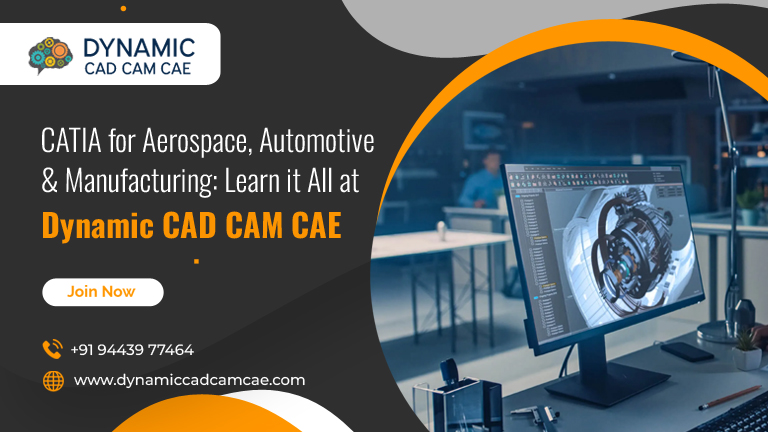The future of product design and engineering lies in digital precision. From designing aircraft fuselages to creating automotive assemblies and industrial tools, today’s engineers rely on advanced 3D software to bring concepts to life. One such leading software is CATIA, widely adopted across the aerospace, automotive, and manufacturing sectors.
To build a successful career in these high-tech industries, hands-on knowledge of CATIA is essential. If you’re located in Tamil Nadu, enrolling in the best CATIA training institute in Chennai — Dynamic CAD CAM CAE — could be your smartest move yet.
CATIA’s Role in Aerospace, Automotive, and Manufacturing Industries
CATIA has become a go-to software for major global industries for one reason: it’s built to handle complexity. Whether it’s an aircraft wing design, an automotive dashboard, or a CNC-machined component, CATIA simplifies the entire design-to-manufacture journey.
Aerospace Sector
In aerospace, CATIA is used to design aircraft structures with absolute precision. Its surface modeling tools are ideal for aerodynamic design, while its assembly features help simulate how thousands of parts interact. Aircraft companies use CATIA to:
- Reduce design errors
- Simulate stress and strain
- Ensure compliance with strict industry standards
Automotive Sector
From body panels to engine blocks, CATIA supports the full development cycle of automotive parts. Its parametric design tools enable rapid changes, while simulation modules help test crashworthiness, heat resistance, and ergonomics. Automotive firms rely on CATIA for:
- Faster prototyping
- Collaborative vehicle development
- Integration with CAM for machining
Manufacturing Sector
Manufacturers across industries use CATIA for everything from tool design to industrial automation. It supports digital mockups, 2D drafting, and product lifecycle integration, allowing companies to innovate quickly and reduce time-to-market.
Why Choose Dynamic CAD CAM CAE – The Best CATIA Training Institute in Chennai
Learning CATIA isn’t just about understanding software features; it’s about mastering how to apply them to real-world engineering problems. That’s where Dynamic CAD CAM CAE excels. The institute is known for blending theory with practical exposure, ensuring every student is job-ready upon course completion.
Here’s why Dynamic stands out:
🔹 Custom-Designed Course Modules
At Dynamic CAD CAM CAE, the course content isn’t generic. Each module is tailored to suit different student profiles, whether you’re a fresher, an experienced professional, or an entrepreneur. The focus is on aligning with global industry requirements.
🔹 Flexible Learning Options
Dynamic understands that students and professionals have different time constraints. That’s why it offers flexible training schedules, including weekday and weekend batches, with one-to-one coaching for personalized learning.
🔹 Real-Time Project-Based Training
Learning CATIA here means working on live industrial projects. Students gain practical experience by solving real challenges from the automotive and aerospace sectors — from component modeling to assembly simulations.
🔹 Expert Trainers with Industry Experience
The trainers at Dynamic aren’t just software experts. We come from engineering backgrounds with rich industry experience in CAD/CAM/CAE. This ensures students get real-time insights and career-oriented guidance.
🔹 Hands-On Workshops and Case Studies
Dynamic regularly organizes skill enhancement workshops and hands-on sessions on the latest features in CATIA. This continuous exposure keeps students updated with evolving technologies and techniques.
🔹 Affordable Fees with Great Value
Despite offering high-end training, Dynamic CAD CAM CAE maintains a very affordable fee structure, making quality education accessible to all engineering students in Chennai and beyond.
🔹 Online CATIA Training
Dynamic offers a comprehensive online CATIA course, delivered live with screen sharing, interactive Q&A, and project review sessions — ideal for outstation learners or working professionals.
Practical Outcomes You Can Expect
After completing the CATIA training at Dynamic CAD CAM CAE, students will be able to:
- Create detailed 2D and 3D part models
- Assemble complex components
- Simulate motion and stress analysis
- Create drafting layouts and technical documentation
- Export models for 3D printing or CNC machining
More importantly, students become capable of thinking like a design engineer, equipped to work in high-demand fields like automotive design, aerospace engineering, mechanical fabrication, and product development.
Who Should Join?
The CATIA course at Dynamic is suitable for:
- Mechanical, Aeronautical, and Automobile Engineering students
- Working professionals seeking career upgrades
- Freelancers wanting to offer 3D design services
- Entrepreneurs in manufacturing, prototyping, or product development
Whether you’re aiming for a job in a multinational or starting your design consultancy, Dynamic CAD CAM CAE can help you build the right foundation.
FAQs about Dynamic CAD CAM CAE
1. How long does the CATIA course take at Dynamic CAD CAM CAE?
The course generally takes 4 to 6 weeks, depending on the depth of training and student availability. Weekend and fast-track options are available.
2. Do I need a mechanical background to learn CATIA?
While it’s ideal, it’s not mandatory. Anyone interested in 3D design, even from civil or electrical backgrounds, can learn with proper guidance at Dynamic.
3. Will I receive a certification after course completion?
Yes, you’ll receive a course completion certificate from Dynamic CAD CAM CAE, recognized by many companies in the engineering and design domain.
4. Is job assistance offered after training?
Definitely. The institute provides placement support, resume-building assistance, and interview guidance to help students land suitable roles.
5. Can I take this course online?
Yes, a full-featured online training option is available, with real-time instructor support, screen sharing, and project review sessions.
6. Will I get hands-on experience during the course?
Absolutely! The training is project-based, with real-time assignments and industry-oriented case studies to build practical skills.
